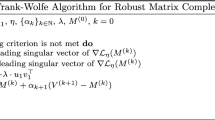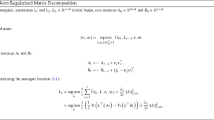Abstract
This paper studies the matrix completion problem under arbitrary sampling schemes. We propose a new estimator incorporating both max-norm and nuclear-norm regularization, based on which we can conduct efficient low-rank matrix recovery using a random subset of entries observed with additive noise under general non-uniform and unknown sampling distributions. This method significantly relaxes the uniform sampling assumption imposed for the widely used nuclear-norm penalized approach, and makes low-rank matrix recovery feasible in more practical settings. Theoretically, we prove that the proposed estimator achieves fast rates of convergence under different settings. Computationally, we propose an alternating direction method of multipliers algorithm to efficiently compute the estimator, which bridges a gap between theory and practice of machine learning methods with max-norm regularization. Further, we provide thorough numerical studies to evaluate the proposed method using both simulated and real datasets.




Similar content being viewed by others
References
Abernethy, J., Bach, F., Evgeniou, T., Vert, J.-P.: A new approach to collaborative filtering: operator estimation with spectral regularization. J. Mach. Learn. Res. 10, 803–826 (2009)
Amit, Y., Fink, M., Srebro, N., Ullman, S.: Uncovering shared structures in multiclass classification. In: Proceedings of the 24th International Conference on Machine Learning. ACM (2007)
Argyriou, A., Evgeniou, T., Pontil, M.: Convex multi-task feature learning. Mach. Learn. 73, 243–272 (2008)
Bennett, J., Lanning, S.: The Netflix prize. In: Proceedings of KDD Cup and Workshop. http://www.cs.uic.edu/~liub/KDD-cup-2007/proceedings.html (2007)
Biswas, P., Liang, T., Toh, K., Wang, T., Ye, Y.: Semidefinite programming approaches for sensor network localization with noisy distance measurements. IEEE Trans. Autom. Sci. Eng. 3, 360–371 (2006)
Cai, J.-F., Candès, E.J., Shen, Z.: A singular value thresholding algorithm for matrix completion. SIAM J. Optim. 20, 1956–1982 (2010)
Cai, T.T., Zhou, W.-X.: Matrix completion via max-norm constrained optimization. Electron. J. Stat. 10, 1493–1525 (2016)
Candès, E.J., Li, X., Ma, Y., Wright, J.: Robust principal component analysis? J. ACM 58, 1–37 (2009)
Candès, E.J., Recht, B.: Exact matrix completion via convex optimization. Found. Comput. Math. 9, 717–772 (2009)
Candès, E.J., Tao, T.: The power of convex relaxation: near-optimal matrix completion. IEEE Trans. Inf. Theory 56, 2053–2080 (2010)
Chen, C., He, B., Yuan, X.: Matrix completion via an alternating direction method. IMA J. Numer. Anal. 32, 227–245 (2012)
Doan, X., Vavasis, S.: Finding approximately rank-one submatrices with the nuclear norm and \(\ell _1\)-norm. SIAM J. Optim. 23, 2502–2540 (2013)
Drusvyatskiy, D., Vavasis, S., Wolkowicz, H.: Extreme point inequalities and geometry of the rank sparsity ball. Math. Program. 152, 521–544 (2015)
Fang, E.X., He, B., Liu, H., Yuan, X.: Generalized alternating direction method of multipliers: new theoretical insights and applications. Math. Prog. Comp. 7, 149–187 (2015)
Fazel, M., Hindi, H., Boyd, S.P.: A rank minimization heuristic with application to minimum order system approximation. In: Proceedings of the American Control Conference, vol. 6. IEEE (2001)
Figueiredo, M., Nowak, R., Wright, S.: Gradient projection for sparse reconstruction: application to compressed sensing and other inverse problems. IEEE J. Sel. Top. Signal Process. 1, 586598 (2007)
Jalali, A., Srebro, N.: Clustering using max-norm constrained optimization. In: Proceedings of the 29th International Conference on Machine Learning (ICML-12) (2012)
Jameson, G.J.O.: Summing and Nuclear Norms in Banach Space Theory, vol. 8. Cambridge University Press, Cambridge (1987)
Keshavan, R.H., Montanari, A., Oh, S.: Matrix completion from noisy entries. J. Mach. Learn. Res. 11, 2057–2078 (2010)
Klopp, O.: Noisy low-rank matrix completion with general sampling distribution. Bernoulli 20, 282–303 (2014)
Koltchinskii, V., Lounici, K., Tsybakov, A.B.: Nuclear-norm penalization and optimal rates for noisy low-rank matrix completion. Ann. Statist. 39, 2302–2329 (2011)
Lee, J., Recht, B., Srebro, N., Tropp, J., Salakhutdinov, R.: Practical large-scale optimization for max-norm regularization. In: Proceedings of the Advances in Neural Information Processing Systems (2010)
Linial, N., Mendelson, S., Schechtman, G., Shraibman, A.: Complexity measures of sign matrices. Combinatorica 27, 439–463 (2007)
Liu, Z., Vandenberghe, L.: Interior-point method for nuclear norm approximation with application to system identification. SIAM J. Matrix Anal. Appl. 31, 1235–1256 (2009)
Mackey, L., Jordan, M.I., Chen, R.Y., Farrell, B., Tropp, J.A.: Matrix concentration inequalities via the method of exchangeable pairs. Ann. Probab. 42, 906–945 (2014)
Negahban, S., Wainwright, M.J.: Restricted strong convexity and weighted matrix completion: optimal bounds with noise. J. Mach. Learn. Res. 13, 1665–1697 (2012)
Netflix (2006). Netflix problem. http://www.netflixprize.com
Oliveira, D.E., Wolkowicz, H., Xu, Y.: ADMM for the SDP relaxation of the QAP. arXiv preprint arXiv:1512.05448 (2015)
Orabona, F., Argyriou, A., Srebro, N.: PRISMA: Proximal iterative smoothing algorithm. arXiv preprint arXiv:1206.2372 (2012)
Recht, B.: A simpler approach to matrix completion. J. Mach. Learn. Res. 12, 3413–3430 (2011)
Recht, B., Fazel, M., Parrilo, P.A.: Guaranteed minimum-rank solutions of linear matrix equations via nuclear norm minimization. SIAM Rev. 52, 471–501 (2010)
Rohde, A., Tsybakov, A.B.: Estimation of high-dimensional low-rank matrices. Ann. Stat. 39, 887–930 (2011)
Shen, J., Xu, H., Li, P.: Online optimization for max-norm regularization. Mach. Learn. 106, 419–457 (2017)
Srebro, N., Rennie, J., Jaakkola, T.S.: Maximum-margin matrix factorization. In: Proceedings of the Advances in Neural Information Processing Systems (2005)
Srebro, N., Salakhutdinov, R.R.: Collaborative filtering in a non-uniform world: learning with the weighted trace norm. In: Proceedings of the Advances in Neural Information Processing Systems (2010)
Srebro, N., Shraibman, A.: Rank, trace-norm and max-norm. In: Proceedings of the 18th Annual Conference on Learning Theory (2005)
Toh, K.-C., Yun, S.: An accelerated proximal gradient algorithm for nuclear norm regularized linear least squares problems. Pac. J. Optim. 6, 615–640 (2010)
Trefethen, L.N., Bau III, D.: Numerical Linear Algebra, vol. 50. SIAM, Philadelphia (1997)
Author information
Authors and Affiliations
Corresponding author
Additional information
K.-C. Toh: Research supported in part by Ministry of Education Academic Research Fund R-146-000-194-112.
Extensions
Extensions
In this section, we consider solving the max-norm constrained version of the optimization problem (2.3). In particular, we consider
This problem can be formulated as an SDP problem as follows:
Let the loss function be
We define the set
Thus, we have an equivalent formulation of (7.2) below, which is more conducive for computation:
We consider the augmented Lagrangian function of (7.3) defined by
where W is the dual variable. Then, it is natural to apply the ADMM to solve the problem (7.3). At the t-th iteration, we update (X, Z; W) by
The next proposition provides a closed-form solution for the Z-subproblem in (7.4).
Proposition 7.1
Denote the observed set of indices of \(M^0\) by \(\Omega = \{(i_t,j_t)\}_{t=1}^n\). For a given matrix \(C\in \mathbb {R}^{d\times d}\), we have

where

and \(\Pi _{[a,b]}(x) = \min \{b,\max (a,x) \}\) projects \(x\in \mathbb {R}\) to the interval [a, b].
We summarize the algorithm for solving the problem (7.2) below.

Rights and permissions
About this article
Cite this article
Fang, E.X., Liu, H., Toh, KC. et al. Max-norm optimization for robust matrix recovery. Math. Program. 167, 5–35 (2018). https://doi.org/10.1007/s10107-017-1159-y
Received:
Accepted:
Published:
Issue Date:
DOI: https://doi.org/10.1007/s10107-017-1159-y




